Back Office Screen Conventions
Most Manager tasks are performed using Xstore Classic's Back Office features. To review the screen convention for the register see, the Oracle Retail Xstore Point of Service Classic User Guide.
Note:
The Register can be accessed from the Back Office by selecting the Register Menu Button.
Bread Crumbs
The bread crumbs keep track of your steps throughout the Back Office menus. When you first enter the Back Office menu, the bread crumb area contains Main Menu.
Note:
Touch-screen users, tap one of the bread crumbs in a Back Office menu header to return to the menu selected in the bread crumb.

Menu List Options
The Back Office functions are available from the Main Menu that is displayed when you log in to the Back Office. Some functions on the list may not be available to all employees. Individual access is based on menu configuration. Security may be different for each employee, employee group, or register group.
The Back Office menu has been restructured into seven options:
-
Associate
-
Till
-
Customer
-
Employee
-
System Admin
-
Inventory
-
Reporting
There are several ways to select a menu item:
-
Type the corresponding number from your keyboard or virtual keyboard.
-
TOUCH-SCREEN Tap the menu option.
-
If there is a long list of options, up and down arrow keys display. Touch-screen users press these arrows to navigate the list. Keyboard users press the keyboard arrows to move the menu list.
Figure 1-2 Back Office Reporting Menu

The number to the left of a menu option represents the keyboard number that executes this option. For example, pressing the number 3 on the keyboard launches the Customer List Report option as shown in Figure 1-2 above.
![]() This symbol to the right of a
menu option indicates that there are additional sub- menus for this
option. If you select a menu option with submenus, Xstore Classic
displays additional functions that are available for that option.
This symbol to the right of a
menu option indicates that there are additional sub- menus for this
option. If you select a menu option with submenus, Xstore Classic
displays additional functions that are available for that option.
If an option is grayed out, the option is not available to the current user. This is configurable by security level. Other menu options may not be available when the register or store is closed.
Figure 1-3 Option Grayed Out

A menu option with a key icon indicates that a security ID is required.
Figure 1-4 Option with Key Icon
Screen Layout
Figure 1-5 Screen Layout Areas
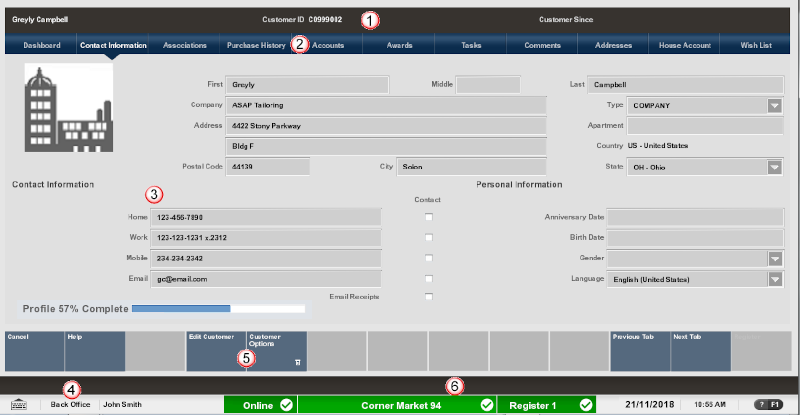
For more information about these Back Office screen areas, refer to:
-
Screen Title (Changes per function)
-
Menu Buttons (availability determined by function and the user's security). See Menu Buttons
Tabs
To open tab screens:
-
Select the Previous tab or Next tab menu button.
-
Touch-screen users, can tap the desired tab.
Menu Buttons
The menu button options can be found on the bottom of most menus and forms. If you are using a keyboard, you can press the associated function key. Menu buttons with the following icons denote additional functions:
Table 1-4 Icons
| Icons | Description |
|---|---|
|
|
This icon indicates there are more sub-menu choices associated with this option. Selecting an option displaying this icon opens another menu with additional options. |
|
|
This icon indicates this function is not available to the user currently signed on to Xstore Classic, without manager override. This function is based on security levels. |
 |
The ellipsis (...) after the word “More" indicates that there are additional menu options available at this screen. Selecting the “More..." option displays another set of menu buttons. |
Function Keys
Note:
Touch-screen users do not use function keys. Instead, tap the menu option to select.
The Xstore Classic menu buttons show the functions that are available for each Xstore Classic window. Each menu button has a function key (F1 - F12) assigned to it. Because each Xstore Classic menu is configurable, the button functions on your system may appear in a different order or have different text than shown throughout this manual.
Some of the functions on a menu may not be available to some employees. Availability of a function depends on menu security, and it may be different for each employee, employee group, or register group.
Note:
Due to the flexibility of the system, menu options in this guide are not identified by a function key number F2, F3, and so on. Instead, the procedures and processes that follow use the name of the button.
Figure 1-6 Back Office Menu Buttons

Note:
Touch-screen users: When your virtual keyboard is visible, you can still access the menu buttons. Tap the desired button above the keyboard.

Message Bar
The message bar is located above the status bar and indicates if there are any new orders. The yellow portions fade in and out when messages are available.
Note:
To view the message bar information here, you must have a touch-screen or a mouse. This additional information is view-only.
Figure 1-7 Message Bar
Select the message to view information.
-
Total New Orders - The total number of new orders.
Figure 1-8 New Order Statistics
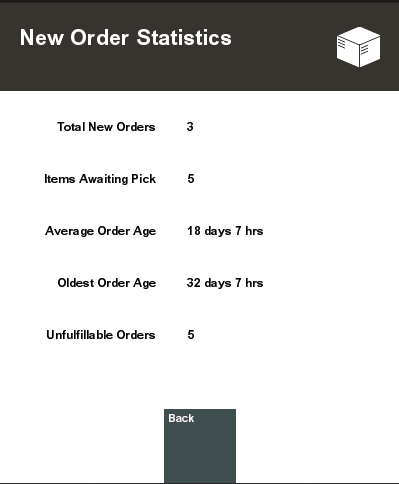
-
Ship Orders - The number of orders waiting to be shipped from this store.
-
Customer Pick Up Orders - The number of orders for pick up in this store.
-
Items Awaiting Pick - The number of items to set aside for the orders.
-
Average Order Age - The average age of the orders awaiting fulfilment, in days and hours, or minutes.
-
Oldest Order Age - The age of the oldest order awaiting fulfilment, in days and hours, or minutes.
-
Unfulfillable Orders -The number of orders that cannot be filled. When an order is rejected and cannot be filled at another location, the status becomes unfulfillable.
Status Bar
The Status Bar is a screen component that displays several sections containing store- related information. It is located immediately below the message bar and is always visible from every Register screen and Back Office screen.
Urgency levels - Stoplight-like color indicators convey urgency:
-
Red = High Urgency
-
Yellow = Medium Urgency
-
Green = Low Urgency (Informational conditions)
Figure 1-9 Status Bar Components
Table 1-5 Status Bar Components
| Component | Description |
|---|---|
|
1. Keyboard icon |
For touch screen monitors, this icon opens the keyboard. |
|
2. Area Locator |
Indicates where you are within the system (that is, Back Office). |
|
3. Signed-In User Identifier |
Identifies the user that is currently signed into Xstore. |
|
4. Database Status Indicator |
Green indicates the Datasources are online. Yellow indicates at least one WAN Datasource is offline. The system is using the local Datasource. Red indicates at least one LAN datasource is offline. Touch-screen users tap the indicator to view the Datasource Status.  |
|
5. Store Identifier |
Identifies your store name and store number. |
|
6. Register Identifier |
Identifies the register number. |
|
7. Date |
Displays the current register date. |
|
8. Time |
Displays the current register time. Touch-screen users swipe the clock area to clock-in/clock-out. |
|
9. F1 |
This icon is available from all screens. Clicking or touching this icon opens the Xstore Classic's help feature. Note: The F1 key is a configurable key. It is not automatically assigned to the Help option. If the help option is enabled and available for the function, pressing the F1 key displays a context-sensitive HTML page. |
Static Information Area
The Static Information Area of a record is in a horizontal bar across the top of the record. The information displayed here is usually some basic identifying information about the current record such as a customer name, an employee ID, or other important information. When viewing a record, the information in the Static Information Area does not change, regardless of which tab is selected for the current record.
The information shown depends upon the kind of record being viewed. If the data originates from another system, the Static Information Area displays the data source where the current record is located. The source varies depending on your system's configuration.
Figure 1-10 Static Information Area - Employee Maintenance Screen
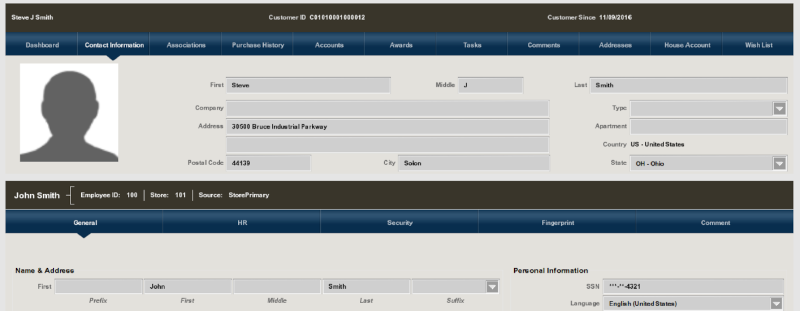
When viewing a customer transaction in the Electronic Journal, the Static Information area displays information about a particular customer transaction.
Figure 1-11 Static Information Area - Electronic Journal
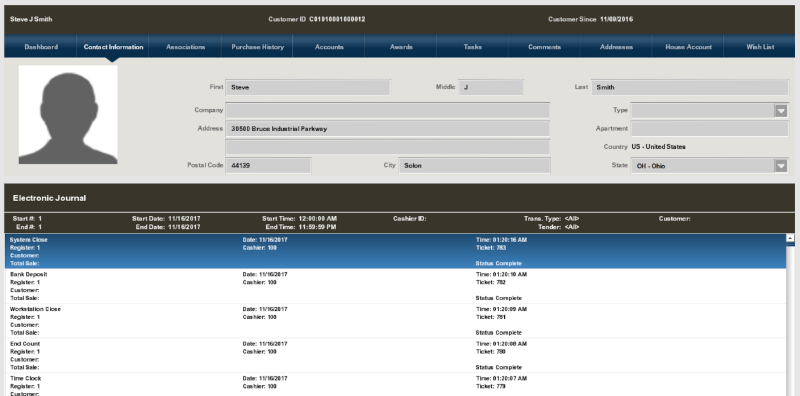
When viewing a customer record in the Customer Maintenance screen, the Static Information area displays the customer’s name, customer account number, enrollment date, and loyalty points (if applicable).
Figure 1-12 Static Information Area - Customer Maintenance

Information Areas
The Information Areas on the screen display information that varies depending on which tab is selected on a record. In that way, the Information Area of a screen is different from the Static Information area at the top of the screen. In the Static Information area, the same set of data displays, regardless of which tab is selected.
An information area is a way of grouping related bits of information that are pertinent to the specific tab currently being displayed.
Figure 1-13 Information Display Area - Contact Information Tab
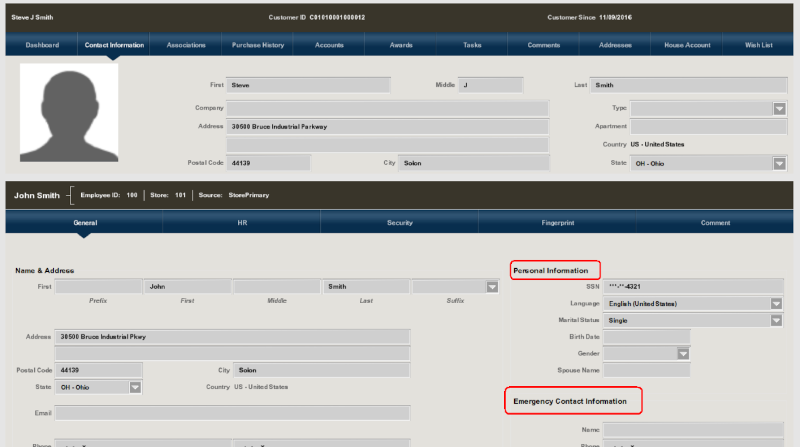
There may be several different Information Areas on a screen, each one containing related information, and visually contained within a boxed area. For example, the customer record may show both Contact Information (such as address and phone information) and Personal information on the Contact Information tab.
Data can usually be entered and edited in an Information Area when you are working in an Edit mode.
Prompts and Forms
During various system operations, you may be prompted to confirm that a process may continue, select from a list of options, acknowledge a system action, enter/select information, and so on. Xstore Classic provides several different types of prompts and forms to help you complete a task.
Response Required Prompt
During a Back Office process, you may be required to confirm an action. For example, in Figure 1-14, below, press Y (Yes) to confirm that you want to close the register or press N (No) to remove the prompt and return to the transaction.
Figure 1-14 Response Required Prompt
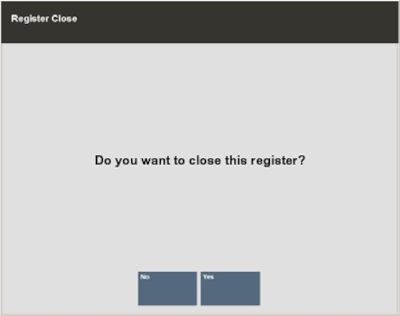
Selection Required Prompt
During a Back Office process, you may be required to select from a list of options. For example, in Figure 1-15 below, you would select a shift from the list. Keyboard users can use the up and down arrow keys to select from the list. To continue with the process, press Enter to choose OK. To exit without selecting, press Esc.
Figure 1-15 Selection Required Prompt
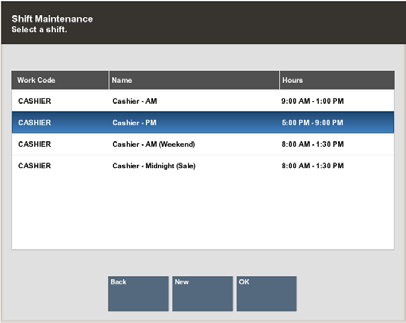
Note:
Touch-screen users tap to select an option and then tap
OK. See Back Office Touch-Screen Navigation.
Required Prompt
During a Back Office process, you may be required to enter a value before continuing. For example, in Figure 1-16 below, you are prompted to enter your employee ID number and password to continue. To continue with the process, enter your employee ID number and password and select Process to continue. To return to the previous screen, press Esc or select Back.
Figure 1-16 Entry Required Prompt
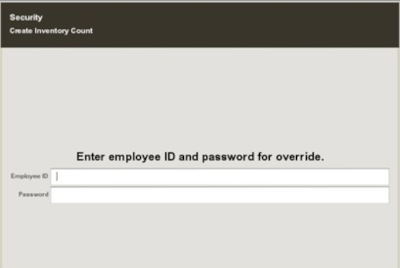
System Information Prompt
Throughout Xstore Classic, the system displays prompts and messages to indicate that it is processing a request or a transaction, or to provide additional information about a process or error. For example, the following system message displays when running a report.
Figure 1-17 System Information Message - Running Report
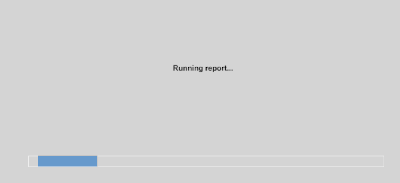
Search Forms
In a search form, you enter parameters, or criteria, to initiate a database search. Xstore Classic displays a search form automatically when you must retrieve specific information.
Some forms (but not all of them) require that you enter at least one letter or one number into a field, the minimum requirement to initiate a search.
Note:
For example, the Employee Lookup form in the Back Office Employee Maintenance function may not require any criteria to be entered. If you select Process without entering criteria, all employee names are retrieved.
The more parameters you enter, the narrower the scope of the search becomes, and fewer records are listed. When one of the parameters is not matched, the system uses the remaining parameters to conduct a broader search. If the system cannot find any matches, Xstore Classic displays a message indicating no match was found.
When applicable, the Change Country menu option provides the ability to search for customers from countries other than the country where the store is located. For example, if you change the country to Canada, the State form field lists Canadian provinces, and if Mexico is selected as the country, then the State form field lists Mexican states.
Because each Xstore Classic search form is configurable, the search parameters on your system may appear in a different order or have different field names than the search forms shown in this guide.
Figure 1-18 Customer Search Form
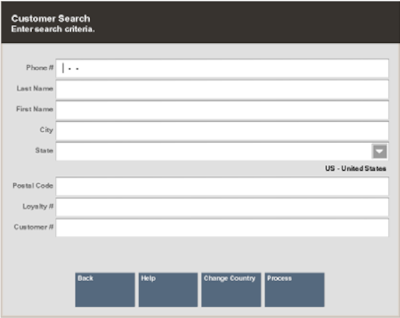
![]() An arrow on the right side of a field
indicates the information for this field must be selected from a drop-down
list of options rather than typed into a free-text field.
An arrow on the right side of a field
indicates the information for this field must be selected from a drop-down
list of options rather than typed into a free-text field.
Data Entry Form
A data entry form is used to capture information that is transferred to the database. For example, the figure below shows a Customer Maintenance form where you can enter various kinds of information about a customer. The same form may be used to display information (read-only) and to update, or edit, information. Usually, you must select an Edit option from the menu before the current information may be changed.
Figure 1-19 Data Entry Form in Edit Mode
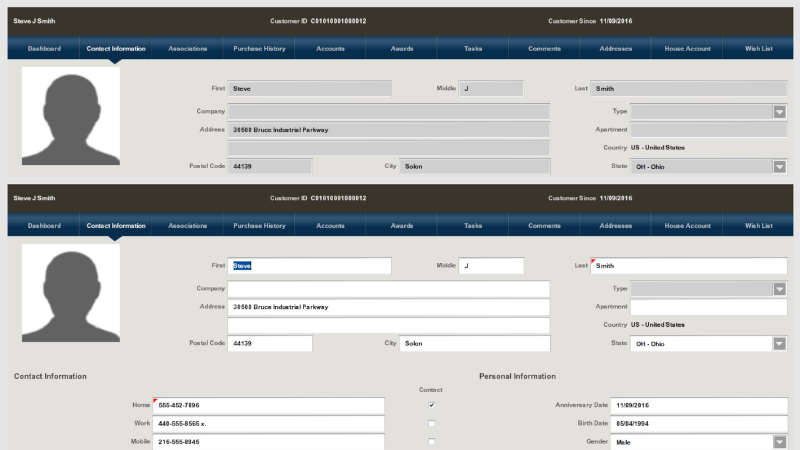
Table 1-6 Icons of the Data Entry Form
| Icons | Description |
|---|---|
|
|
An arrow on the right side of a field indicates the information for this field must be selected from a drop-down list of options rather than typed into a free-text field. |
|
|
A red triangle in the upper left corner of a field indicates that information must be entered. |
|
|
A grayed out field indicates the field is non-editable. In some cases, select the Edit menu option to modify the field. |
Enter the information into the form as required and select Save Changes to continue or press Esc to return to the previous screen without saving the data. If you select Save Changes before completing all the required fields, Xstore Classic displays a message explaining the error.